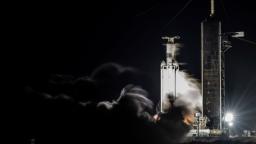

Sign up for CNN’s Wonder Theory science newsletter. Explore the universe with news on fascinating discoveries, scientific advancements and more.
CNN
—
SpaceX’s Falcon Heavy — a towering, three-pronged vehicle that is the most powerful operational rocket in the world — returned to the skies on Tuesday for the first time since mid-2019.
The rocket launched at 9:41 a.m. ET from NASA’s Kennedy Space Center in Florida, hauling satellites to space for the US military in a secretive mission dubbed USSF-44.
The Falcon Heavy debuted in 2018 to much fanfare as SpaceX CEO Elon Musk elected to launch his personal Tesla Roadster as a test payload on the launch. The car is still in space, taking an oblong path around the sun that swings out as far as Mars’ orbital path.
Since that first test mission, SpaceX has launched only two other Falcon Heavy missions, both in 2019. One sent a hulking TV and phone service satellite to orbit for Saudi Arabia-based Arabsat, and the other delivered a batch of experimental satellites for the US Department of Defense.
But the rocket had not launched since 2019, as the vast majority of SpaceX’s missions don’t require the Falcon Heavy’s amped up power. SpaceX’s workhorse Falcon 9 rocket, on the other hand, has launched nearly 50 missions so far this year alone.
With each Falcon Heavy launch, the rocket puts on a dramatic showing back on Earth.
SpaceX has attempted to land all three of the rocket’s boosters — the tall white sticks that are strapped together to give the rocket its heightened power at liftoff — back on landing pads on land and at sea so that they can be refurbished and reused on future missions. It does this to cut down on mission costs.
SpaceX has yet to land and recover all three rocket boosters after the same mission, although it’s come dramatically close. The two side boosters made a pinpoint, synchronized landing on ground pads after an April 2019 mission, and the rocket’s center booster touched down on a sea-faring platform. But then, rough waves at sea toppled it over.
After Tuesday’s mission, the company only attempted to recover two of the Falcon Heavy rocket’s first-stage rocket boosters. The center booster was left to plunge into the ocean, where it’ll remain discarded, because it did not have enough leftover fuel to guide its journey home, according to a news release from the US military’s Space Systems Command.
The side boosters, however, made their signature synchronized landing on ground pads near the Florida coastline.
Though the Falcon Heavy is the most powerful operational rocket in the world, there are two massive rockets waiting in the wings to claim that title.
NASA’s Space Launch System, or SLS, rocket, which is currently slated to attempt its inaugural launch later in November to send the uncrewed Artemis 1 mission around the moon, is sitting in the Kennedy Space Center’s towering Vehicle Assembly Building, which lies just a few miles from the launch pad where the Falcon Heavy will take flight.
While the Falcon Heavy gives off about five million pounds of thrust, SLS is expected to put off as much as 8.8 million pounds of thrust — 15% more thrust than the Saturn V rockets that powered the mid-20th Century moon landings.
And just across the Gulf Coast, at SpaceX’s experimental facilities in South Texas, the company is in the final stages of preparing for the first orbital launch attempt of its Starship spacecraft and Super Heavy rocket. Though the test flight is still awaiting final approval from federal regulators, it could take flight before the end of the year.
The Starship system is expected to out-power both SLS and Falcon Heavy by a wide margin. The forthcoming Super Heavy booster, which is designed to vault the Starship spacecraft into space, is expected to put off about 17 million pounds of thrust alone.
Both the SLS rocket and SpaceX’s Starship are integral to NASA’s plans to return astronauts to the surface of the moon for the first time in half a century.
SpaceX also has its own, ambitious vision for the Starship: ferrying humans and cargo to Mars in the hopes of one day establishing a permanent human settlement there.
There is not much publicly available information about the USSF-44 mission. In a news release, the US military’s Space Systems Command said only that the launch will put multiple satellites into orbit on behalf of the Space Systems Command’s Innovation and Prototyping Delta, which is focused on quickly developing space technology as it relates to tracking objects in space as well as a range of other activities.
The Space System Command declined to provide additional information about the mission when reached by email. It referred questions to the Office of the Secretary of the Air Force, which also declined comment.
The US military is one of the primary drivers of the domestic rocket economy, doling out lucrative launch contracts that are coveted by private launch companies including SpaceX and its chief competitor in the area, United Launch Alliance, which is a joint operation between Boeing and Lockheed Martin.
